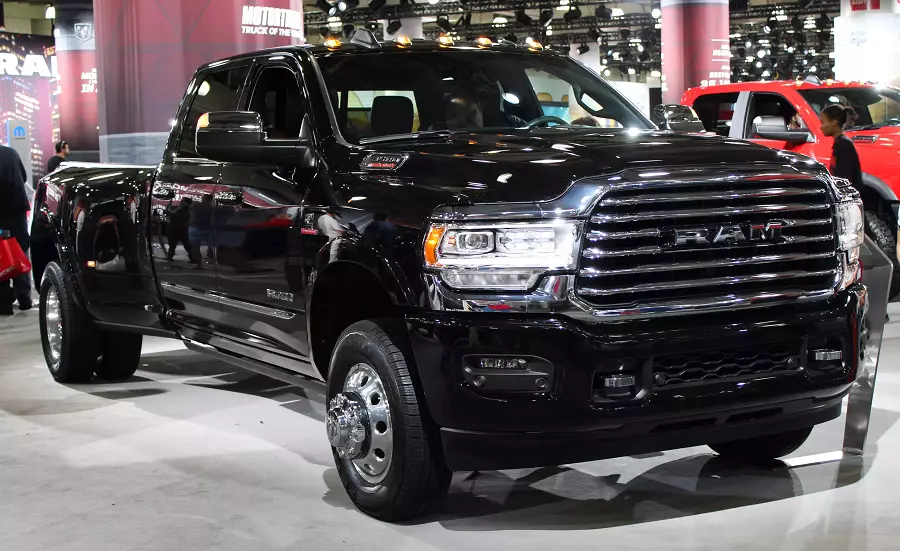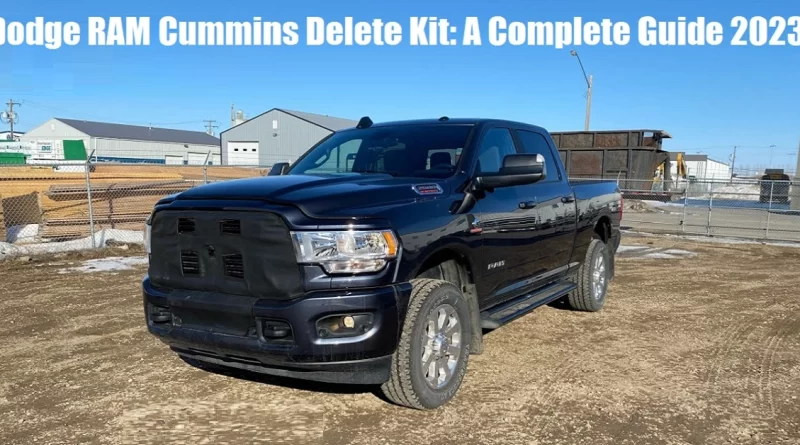Dodge RAM Cummins Delete Kit: A Complete Guide 2023
When it comes to maximizing the performance and efficiency of your Dodge RAM Cummins diesel truck, a delete kit can be a game-changer. A “delete kit” refers to a set of components and modifications that remove or bypass certain emissions control systems, such as the Diesel Particulate Filter (DPF), Exhaust Gas Recirculation (EGR) system, and Selective Catalytic Reduction (SCR) system. In this comprehensive guide, we will delve into the details of the Dodge RAM Cummins delete kit, exploring its benefits, installation process, legal considerations, and also common frequently asked questions.

Understanding the Dodge RAM Cummins Delete Kit
The Dodge RAM Cummins delete kit is designed to optimize the performance of your diesel truck by eliminating restrictive emissions control systems. By removing or bypassing components like the DPF, EGR, and SCR, the kit allows for increased airflow, reduced exhaust gas recirculation, and also improved fuel combustion.
Benefits of Using a Delete Kit
- Enhanced Performance: The delete kit can significantly improve the horsepower and torque output of your Dodge RAM Cummins engine, providing a noticeable boost in overall performance.
- Increased Fuel Efficiency: By eliminating the restrictive emissions components, the delete kit can improve fuel efficiency, allowing for longer trips and reduced fuel costs.
- Extended Engine Life: With the removal of the DPF and EGR systems, the engine operates under less stress, reducing the likelihood of costly repairs and prolonging its lifespan.
- Reduced Maintenance: Without the need for periodic regeneration cycles and potential issues associated with emissions systems, maintenance requirements are simplified.
Components Included in a Cummins Delete Kit
A typical Dodge RAM Cummins delete kit may include the following components:
- Performance Tuner: A specialized device that reprograms the engine control module (ECM) to optimize performance after the emissions systems are removed.
- Delete Pipes: These pipes replace the DPF and SCR components, allowing for improved exhaust flow and reduced backpressure.
- EGR Delete Kit: This kit removes the EGR valve and related components, preventing exhaust gas from recirculating into the intake manifold.
- DEF Delete Kit: In trucks equipped with a Selective Catalytic Reduction (SCR) system, a DEF delete kit eliminates the need for Diesel Exhaust Fluid (DEF).
Installation Process (Dodge RAM Cummins Delete Kit)
The installation process of a Dodge RAM Cummins delete kit typically involves the following steps:
- Gather the necessary tools and ensure safety precautions are in place.
- Disconnect the battery to prevent any electrical mishaps.
- Remove the DPF, EGR valve, SCR components, and other associated parts.
- Install the delete pipes, ensuring a proper fit and tight connection.
- Install the EGR delete kit, if applicable.
- Program the ECM using the performance tuner to optimize engine performance.

It is crucial to follow the manufacturer’s instructions and guidelines during the installation process to ensure a successful and safe modification.
Legal Considerations
Before proceeding with a delete kit installation, it’s essential to understand the legal implications. In many regions, tampering with emissions control systems is illegal for on-road vehicles. It’s important to research and comply with the laws and regulations specific to your area. While a delete kit may offer performance benefits, it’s crucial to understand the potential legal consequences before proceeding.
Some delete kits are designed and marketed for off-road or racing use only, which may be permissible in certain circumstances. However, it’s essential to verify the legality of using such kits in your location and ensure compliance with local regulations.
Additionally, removing emissions control systems may void your vehicle’s warranty. It’s recommended to consult with the manufacturer or authorized dealerships to understand the warranty implications before making any modifications.
Maintenance and Care ((Dodge RAM Cummins Delete Kit))
After installing a delete kit on your Dodge RAM Cummins, it’s important to perform regular maintenance and care to keep your truck running smoothly. Here are some key points to consider:
- Regularly inspect and clean the delete kit components to ensure proper functionality and prevent clogging or buildup.
- Monitor the performance of your truck after the installation. If you notice any abnormal issues or warning lights, consult with a qualified mechanic.
- Follow the manufacturer’s guidelines for tuning and performance adjustments to maintain optimal engine operation.
- Keep up with routine maintenance tasks such as oil changes, filter replacements, and fluid checks to ensure the overall health of your vehicle.
By staying proactive with maintenance, you can enjoy the benefits of your delete kit while keeping your truck in top shape.
Performance Enhancements
One of the primary reasons truck owners opt for a delete kit is the performance improvements it offers. By removing the restrictive emissions components, you can experience notable enhancements, including:
- Increased horsepower and torque: With improved airflow and combustion, your Dodge RAM Cummins engine can deliver more power and torque, translating to better acceleration and towing capabilities.
- Enhanced throttle response: By eliminating lag caused by the emissions systems, the engine can respond more quickly to your commands, providing a more engaging driving experience.
- Improved towing capacity: The increased power and torque output can significantly enhance your truck’s towing capacity, allowing you to haul heavier loads with ease.
These performance upgrades make a delete kit an appealing choice for truck enthusiasts looking to unlock the full potential of their Dodge RAM Cummins.
Fuel Efficiency Improvements
In addition to performance gains, a delete kit can positively impact your truck’s fuel efficiency. Here’s how:
- Reduced fuel consumption: The removal of emissions systems reduces exhaust backpressure, allowing the engine to operate more efficiently. This efficiency leads to improved fuel economy, saving you money on fuel costs.
- Elimination of regeneration cycles: The DPF regeneration process, which burns off accumulated soot, can consume additional fuel. With the DPF removed, your truck no longer needs these regeneration cycles, further improving fuel efficiency.
It’s important to note that individual results may vary, and driving habits, terrain, and other factors can influence fuel economy. However, many truck owners report noticeable improvements in MPG (miles per gallon) after installing a delete kit.
Common Concerns and Misconceptions
As with any modification, there are common concerns and misconceptions surrounding delete kits. Let’s address a few of them:
- “Will using a delete kit damage my engine?” When installed correctly and paired with proper maintenance, a delete kit is unlikely to cause direct engine damage. However, inadequate installation or neglecting maintenance can lead to issues, so it’s crucial to follow guidelines and perform routine checks.
- “Is using a delete kit safe for the environment?” Delete kits are designed for off-road or racing purposes and are not compliant with emissions standards. They should not be used on public roads as they contribute to increased emissions. It’s important to be mindful of environmental impact and adhere to local regulations.
- “Will a delete kit affect my vehicle’s resale value?” While a delete kit may appeal to certain buyers in the aftermarket, it’s important to understand that modifying your vehicle can have an impact on its resale value. Some buyers may prefer a truck with all emissions systems intact. It’s recommended to weigh the potential performance benefits against any potential depreciation in value.
Frequently Asked Questions (FAQs)
Q1: Are delete kits legal for on-road use? A1: Delete kits that remove emissions control systems are generally not legal for on-road use. It’s crucial to research and comply with the laws and regulations specific to your area.
Q2: Will installing a delete kit void my truck’s warranty? A2: Removing emissions control systems may void your vehicle’s warranty. It’s advisable to consult with the manufacturer or authorized dealerships to understand the warranty implications before making any modifications.
Q3: Can I install a delete kit myself, or should I seek professional assistance? A3: The installation process can be complex and requires technical knowledge. It’s recommended to seek professional assistance to ensure proper installation and avoid any potential issues.
Q4: Will a delete kit improve my truck’s fuel efficiency? A4: Yes, a delete kit can improve fuel efficiency by eliminating the need for regeneration cycles and reducing exhaust backpressure. However, individual results may vary based on driving habits and other factors.
Q5: What maintenance is required after installing a delete kit? A5: Regular inspection and cleaning of delete kit components, along with routine maintenance tasks like oil changes and filter replacements, are important to maintain optimal performance.
Also Read: Ecodiesel Delete Kit Dodge & Jeep – The Ultimate Guide 2023
Conclusion
In conclusion, the Dodge RAM Cummins delete kit offers truck owners a way to optimize performance and fuel efficiency. By removing restrictive emissions control systems, truck enthusiasts can experience increased horsepower, torque, and improved fuel economy. However, it’s important to consider the legal implications, potential warranty voiding, and environmental impact before installing a delete kit. Consulting with professionals and adhering to local regulations is crucial to ensure a safe and compliant modification.
For more information and to explore your options, consider reaching out to authorized dealerships or trusted automotive experts.
Also Read: How to Improve Your Business Plan 2023 – Ultimate Guide




